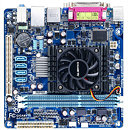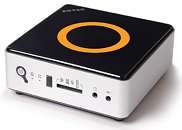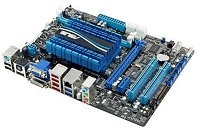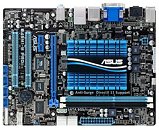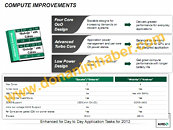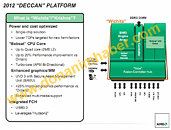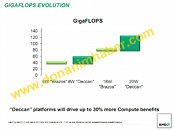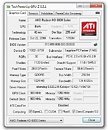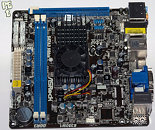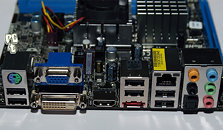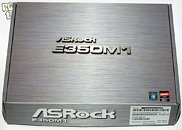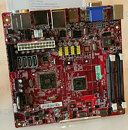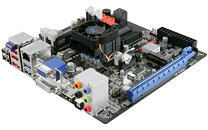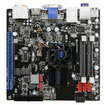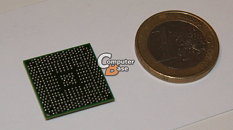Apr 16th, 2025 10:08 EDT
change timezone
Latest GPU Drivers
New Forum Posts
- The TPU UK Clubhouse (26117)
- 5070ti overclock...what are your settings? (6)
- Help me identify Chip of this DDR4 RAM (21)
- Last game you purchased? (772)
- Windows 11 fresh install to do list (23)
- How to relubricate a fan and/or service a troublesome/noisy fan. (229)
- GPU Memory Temprature is always high (16)
- Help For XFX RX 590 GME Chinese - Vbios (4)
- PCGH: "hidden site" to see total money spend on steam (3)
- Share your AIDA 64 cache and memory benchmark here (3053)
Popular Reviews
- G.SKILL Trident Z5 NEO RGB DDR5-6000 32 GB CL26 Review - AMD EXPO
- ASUS GeForce RTX 5080 TUF OC Review
- DAREU A950 Wing Review
- The Last Of Us Part 2 Performance Benchmark Review - 30 GPUs Compared
- Sapphire Radeon RX 9070 XT Pulse Review
- Sapphire Radeon RX 9070 XT Nitro+ Review - Beating NVIDIA
- Upcoming Hardware Launches 2025 (Updated Apr 2025)
- Thermaltake TR100 Review
- Zotac GeForce RTX 5070 Ti Amp Extreme Review
- TerraMaster F8 SSD Plus Review - Compact and quiet
Controversial News Posts
- NVIDIA GeForce RTX 5060 Ti 16 GB SKU Likely Launching at $499, According to Supply Chain Leak (182)
- NVIDIA Sends MSRP Numbers to Partners: GeForce RTX 5060 Ti 8 GB at $379, RTX 5060 Ti 16 GB at $429 (124)
- Nintendo Confirms That Switch 2 Joy-Cons Will Not Utilize Hall Effect Stick Technology (105)
- Over 200,000 Sold Radeon RX 9070 and RX 9070 XT GPUs? AMD Says No Number was Given (100)
- Nintendo Switch 2 Launches June 5 at $449.99 with New Hardware and Games (99)
- Sony Increases the PS5 Pricing in EMEA and ANZ by Around 25 Percent (85)
- NVIDIA PhysX and Flow Made Fully Open-Source (77)
- NVIDIA Pushes GeForce RTX 5060 Ti Launch to Mid-April, RTX 5060 to May (77)
News Posts matching #Zacate
Return to Keyword Browsing
Gigabyte Intros E350N WIN8 Mini-ITX Motherboard
Gigabyte rolled out a new mini-ITX motherboard based on the AMD E350 "Zacate" APU, for entry-level PC and home-server builds, the E350N-WIN8. As the name might suggest, the board is designed to run Windows 8 with its entire feature set, including Fast Boot. It does that by replacing legacy AwardBIOS on older variants, with modern AMI UEFI, backed by Gigabyte's Dual-UEFI redundant BIOS technology that protects against failed BIOS updates. The E350N WIN8 uses a fairly big (SFF-safe) fan-heatsink to cool the APU, while a tiny heatsink cools its companion A45 FCH chipset.
The AMD E350 packs two x86-64 cores clocked at 1.60 GHz, with a maximum memory support of 16 GB, and AMD Radeon HD 6310D DirectX 11 graphics that rides on 80 stream processors. The APU is wired to two standard-size 240-pin DIMM slots. The lone expansion slot, sadly, is a legacy PCI. The board draws power from a combination of 24-pin and 4-pin ATX connectors. Connectivity includes four SATA 3 Gb/s ports, eight USB 2.0/1.1 ports (four on the rear panel, four by headers), serial RS232 (COM) and parallel (LPT) ports, PS/2 mouse and keyboard connectors, and display outputs that include D-Sub (VGA) and HDMI (with 7.1-channel digital HD audio). Expect a sub-$100 price point.
The AMD E350 packs two x86-64 cores clocked at 1.60 GHz, with a maximum memory support of 16 GB, and AMD Radeon HD 6310D DirectX 11 graphics that rides on 80 stream processors. The APU is wired to two standard-size 240-pin DIMM slots. The lone expansion slot, sadly, is a legacy PCI. The board draws power from a combination of 24-pin and 4-pin ATX connectors. Connectivity includes four SATA 3 Gb/s ports, eight USB 2.0/1.1 ports (four on the rear panel, four by headers), serial RS232 (COM) and parallel (LPT) ports, PS/2 mouse and keyboard connectors, and display outputs that include D-Sub (VGA) and HDMI (with 7.1-channel digital HD audio). Expect a sub-$100 price point.

APUs Make Up Nearly 75% of AMD's Processor Sales
Despite losing in market share to Intel, AMD has reason to cheer as its APU gambit is beginning to pay off. According to the latest architecture- and core count-specific sales figures for AMD given out by Mercury Research detailing Q3-2013 in context of two preceding quarters, APUs make for nearly 75% of AMD's processor sales, and the company's recently-launched "Trinity" line of desktop and mobile APUs are off to a flying start.
The most popular chips in AMD's stable are its "Bobcat" Zacate series low-power APUs, which are being built into entry-level computing devices such as netbooks, nettops, and all-in-one desktops. The chips make up 39 percent of AMD's sales in Q3, followed by another APU line, the A-Series "Trinity", which is available in desktop and mobile variants, offers a combination of a fast integrated graphics processor with up to four CPU cores, and makes up 26.1 percent of AMD's sales. AMD's A-Series "Llano" can still be bought in the market, and makes up 7.4 percent of AMD's sales in Q3.
The most popular chips in AMD's stable are its "Bobcat" Zacate series low-power APUs, which are being built into entry-level computing devices such as netbooks, nettops, and all-in-one desktops. The chips make up 39 percent of AMD's sales in Q3, followed by another APU line, the A-Series "Trinity", which is available in desktop and mobile variants, offers a combination of a fast integrated graphics processor with up to four CPU cores, and makes up 26.1 percent of AMD's sales. AMD's A-Series "Llano" can still be bought in the market, and makes up 7.4 percent of AMD's sales in Q3.

ZOTAC ZBox Mini PC to Get VIA Nano X2 Power
ZOTAC is readying a new ZBox mini-PC model that makes use of VIA Nano X2 ultra-low power x86 platform. Nano X2-powered ZBox models have been already spotted in the Japanese market. The new ZBox model will make use of Nano X2 U4025, which is a dual-core processor clocked at 1.20 GHz. While VIA is the smallest x86 processor vendor, in the ULV category, the company does tend to punch above its weight, competing with low-wattage Intel Atom processors.
The Nano X2 U4025 processor will be backed by VIA VX900H chipset, with integrated S3 Graphics. The VIA-powered ZBox will be available in two SKUs: a complete product, and a barebones package to which you have to add some of your own compatible components. Both will support up to 4 GB of DDR3 memory, a 2.5-inch SATA bay will be provided to install a hard drive or SSD. Most other features will be consistent with other ZBox models: 6-in-1 card reader, Gigabit Ethernet, 802.11 b/g/n WiFi, Bluetooth 3.0, USB 3.0 connectivity, as well as HDMI and DisplayPort outputs. Originally based on the Intel Atom platform, ZOTAC's ZBox is available in AMD Fusion "Zacate" platform apart from the new VIA-powered one. The new ZBox models will be available worldwide by the end of this month.
The Nano X2 U4025 processor will be backed by VIA VX900H chipset, with integrated S3 Graphics. The VIA-powered ZBox will be available in two SKUs: a complete product, and a barebones package to which you have to add some of your own compatible components. Both will support up to 4 GB of DDR3 memory, a 2.5-inch SATA bay will be provided to install a hard drive or SSD. Most other features will be consistent with other ZBox models: 6-in-1 card reader, Gigabit Ethernet, 802.11 b/g/n WiFi, Bluetooth 3.0, USB 3.0 connectivity, as well as HDMI and DisplayPort outputs. Originally based on the Intel Atom platform, ZOTAC's ZBox is available in AMD Fusion "Zacate" platform apart from the new VIA-powered one. The new ZBox models will be available worldwide by the end of this month.

ASUS Intros E45M1-M PRO Fusion Motherboard with AMD E-450 APU
ASUS released a new embedded micro-ATX motherboard based on AMD's Fusion "Zacate" processor platform. The new E45M1-M PRO from ASUS resembles the E35M1-M PRO, except that it's powered by the newer AMD E-450 dual-core APU. Clocked at 1.65 GHz, the E-450 combines two Bobcat architecture x86-64 cores with Radeon HD 6320 DirectX 11-compliant graphics packing 80 stream processors, and a DDR3-1333 MHz integrated memory controller. The E45M1-M PRO measures 244 x 183 mm, and makes use of all of its expansion area to provide four expansion slots: a PCI-Express 2.0 x16, a PCI-E x1, and two legacy PCI.
The board draws power from standard 24-pin ATX with 4-pin CPU power. A 3-phase VRM handles APU power, it is backed by ASUS EPU chip that works to improve energy efficiency. The APU is wired to two DDR3 DIMM slots, for single-channel DDR3 memory. A large heatsink cools both the APU and Hudson M1 chipset, optionally a fan can be attached to cool it better.
The board draws power from standard 24-pin ATX with 4-pin CPU power. A 3-phase VRM handles APU power, it is backed by ASUS EPU chip that works to improve energy efficiency. The APU is wired to two DDR3 DIMM slots, for single-channel DDR3 memory. A large heatsink cools both the APU and Hudson M1 chipset, optionally a fan can be attached to cool it better.

AMD's Next-Generation Wichita and Krishna APUs Detailed
In its latest presentation to industry partners, AMD detailed its upcoming Deccan low-power computing platform, targeting the market Intel's Atom and VIA's Nano processors do. AMD is currently behind the "Zacate" and "Ontario" processors, which deliver high performance/watt x86 computing at low power draw and costs. The company's future platform will be called "Deccan," consisting of processors codenamed "Wichita" and "Krishna," targeting the ULV desktop and netbook markets, respectively. With the next generation, AMD is looking to take advantage of the 28 nanometer manufacturing process to put four x86-64 cores based on the Bobcat architecture on a single piece of silicon, with an integrated memory controller and AMD Radeon discrete-class graphics.
The biggest change here isn't the fact that there are four cores, or that it's built on 28 nm, but that Wichita and Krishna are completely single-chip. The FCH or Fusion Controller Hub has been completely fused into the APU silicon. Motherboards and notebook logic boards will have just one big chip, with no "chipset" of any form. This makes AMD's Wichita and Krishna the industry's very first true x86-based consumer SoC (system on chip). The integrated memory controller now supports DDR3-1600 MHz memory. The integrated AMD Radeon graphics is set to get a performance and SIMD boost, as well, including a Secure Asset Management Unit (SAMU). AMD's next generation APUs are slated for 2012.
The biggest change here isn't the fact that there are four cores, or that it's built on 28 nm, but that Wichita and Krishna are completely single-chip. The FCH or Fusion Controller Hub has been completely fused into the APU silicon. Motherboards and notebook logic boards will have just one big chip, with no "chipset" of any form. This makes AMD's Wichita and Krishna the industry's very first true x86-based consumer SoC (system on chip). The integrated memory controller now supports DDR3-1600 MHz memory. The integrated AMD Radeon graphics is set to get a performance and SIMD boost, as well, including a Secure Asset Management Unit (SAMU). AMD's next generation APUs are slated for 2012.

Acer Readying Tablets Based on AMD Z-Series APUs
Acer has just placed an order for 80,000 pieces of AMD Z-series accelerated processing units. Based on essentially the same design as Fusion "Zacate", Z-series APUs are designed to have lower TDP and to be of higher quality, so they could be deployed in enterprise and IPC (industrial PC) environments. The AMD Z-01 is Acer's choice, this chip combines two x86-64 cores clocked at 1.00 GHz with AMD Radeon HD 6250 DirectX 11 compliant graphics, and a DDR3 memory controller. The TDP of the entire chip stands at 5.9W, it is built on the 40 nm process at TSMC.
Acer's first tablets based on AMD Z-01 will run Windows 7, since Android 3.0 (codenamed "Ice Cream Sandwich") is not going to be out any time before the end of 2011. Acer isn't the only big tablet-maker opting for AMD Z-series over Intel's Atom Pine Trail platform, MSI is also reported to be working on x86 tablets running AMD Z-series. Manufacturers are opting for Z-series over Pine Trail, because the latter has both higher price and TDP. With its relatively faster iGPU, Z-series should be able to drive graphics-intensive custom user-interfaces on tables sized up to 10.1-inches. Industry sources expect AMD to ship up to 500,000 units of the chip in the second half of 2011.
Acer's first tablets based on AMD Z-01 will run Windows 7, since Android 3.0 (codenamed "Ice Cream Sandwich") is not going to be out any time before the end of 2011. Acer isn't the only big tablet-maker opting for AMD Z-series over Intel's Atom Pine Trail platform, MSI is also reported to be working on x86 tablets running AMD Z-series. Manufacturers are opting for Z-series over Pine Trail, because the latter has both higher price and TDP. With its relatively faster iGPU, Z-series should be able to drive graphics-intensive custom user-interfaces on tables sized up to 10.1-inches. Industry sources expect AMD to ship up to 500,000 units of the chip in the second half of 2011.

AMD A-Series APUs Tested Against Sandy Bridge CPUs at Gaming on IGP
What happens when you pit Intel's "Visually Smart" Sandy Bridge processors against Radeon-enriched AMD Fusion A-Series accelerated processing units? They do terribly at gaming on integrated graphics. Surprise! That is notwithstanding the fact that AMD is pitching its A-Series Fusion APUs to be a lot more than CPUs with embedded GPUs, they're pitched to be processors that make lower-mainstream graphics pointless, and to alter the software ecosystem to be more GPGPU intensive, so applications could benefit from the over 500 GFLOPs of computation power the 400 stream processor DirectX 11 GPU brings to the table.
A leaked presentation slide shows AMD's performance projections for the A-Series GPU, tests included GPU-heavy DirectX 10 titles such as Crysis Warhead and Borderlands; as well as DirectX 11 ready titles such as Dirt 2. AMD's quad-core A8-3850, A8-3650 and A8-3450 were included alongside Intel's dual-core Sandy Bridge Core i3-2100, and quad-core Core i5-2300, Core i5-2500K. The Atom-competitive E350 Zacate dual-core was also in the comparision, perhaps to show that it is nearly as good as Intel's much higher segment Core series processors at graphics.
A leaked presentation slide shows AMD's performance projections for the A-Series GPU, tests included GPU-heavy DirectX 10 titles such as Crysis Warhead and Borderlands; as well as DirectX 11 ready titles such as Dirt 2. AMD's quad-core A8-3850, A8-3650 and A8-3450 were included alongside Intel's dual-core Sandy Bridge Core i3-2100, and quad-core Core i5-2300, Core i5-2500K. The Atom-competitive E350 Zacate dual-core was also in the comparision, perhaps to show that it is nearly as good as Intel's much higher segment Core series processors at graphics.
FinalWire Announces AIDA64 v1.60
FinalWire released the latest update to AIDA64, a comprehensive system information, diagnostic, and benchmarking suite for engineers and enthusiasts alike. Version 1.60 introduces a host of changes. To begin with support for AMD's Fusion "Ontario" and "Zacate" APUs was added, it was improved for Intel's "SandyBridge" processors. Tests in the benchmark suite which became 64-bit optimized since AIDA64's first release, is now optimized for the AVX SIMD instruction set. PCI-Express 3.0 controllers and devices are now supported. Support for new AMD Radeon HD 6000 series and NVIDIA GeForce GTX 560 Ti GPUs was added. Lastly, support for AMD and JMicron storage controllers was improved.DOWNLOAD: FinalWire AIDA64 1.60 EXE Installer, ZIP Package

TechPowerUp GPU-Z 0.5.1 Released
TechPowerUp introduced version 0.5.1 of GPU-Z, our lightweight graphics sub-system information and monitoring utility. GPU-Z provides you with technical details of your installed graphics processors, and lets you monitor clock speeds, voltages, temperatures and fan speeds. This month's release adds support for new GPUs, improves stability, and corrects some minor bugs. To begin with, detection for the new NVIDIA GeForce GTX 560 Ti graphics processor is added, alongside GeForce GTX 480M, and GeForce GTX 485M. Detection was improved for GeForce GTX 460M, GT 445M, and GT 435M. Early support for AMD's Fusion Llano, Ontario, and Zacate-embedded APUs were also added.
With the latest driver, NVIDIA had blocked our power-throttling disable parameter. We found our way around it, and using a new method, fixed the "/GTX500OCP" parameter using which you can override NVIDIA's power throttling feature. Support for new voltage controllers used by the latest batches of Radeon HD 6800/HD 6900 series graphics cards were also added. A number of stability improvements were made, and bugs fixed. The updates notifier is less pesky, it checks for timely updates in the background when GPU-Z is launched (according to update check frequency defined by user), and appears to users only if it finds that new updates are available.DOWNLOAD: TechPowerUp GPU-Z v0.5.1
A complete list of changes follows.
With the latest driver, NVIDIA had blocked our power-throttling disable parameter. We found our way around it, and using a new method, fixed the "/GTX500OCP" parameter using which you can override NVIDIA's power throttling feature. Support for new voltage controllers used by the latest batches of Radeon HD 6800/HD 6900 series graphics cards were also added. A number of stability improvements were made, and bugs fixed. The updates notifier is less pesky, it checks for timely updates in the background when GPU-Z is launched (according to update check frequency defined by user), and appears to users only if it finds that new updates are available.DOWNLOAD: TechPowerUp GPU-Z v0.5.1
A complete list of changes follows.

ASRock Unveils E350M1 AMD Fusion ''Brazos'' Mini-ITX Motherboard
Better late than never. ASRock finally unveiled its mini-ITX motherboard based on the AMD Brazos platform, featuring AMD Fusion "Zacate" E-350 accelerated processing unit (APU). The APU integrates two x86-64 processing cores based on the "Bobcat" architecture with a DirectX 11 compliant AMD Radeon HD 6310 graphics processing core. The ASRock E350M1 is a typical mini-ITX embedded platform motherboard. The board draws power from a standard 24-pin ATX power connector (20-pin will do), though from the looks of it, the same PCB can be reconfigured to have a 2-pin 12V DC power external input for use in some very tight cases.
The APU is wired to two DDR3 DIMM slots, the lone expansion slot is a PCI-Express 2.0 x16 (electrical 2.0 x4). The E-350 APU and Hudson M1 chipset have separate heatsinks, the one over the APU is ventilated by a small fan. The chipset gives out four SATA 6 Gb/s ports, and one eSATA 6 Gb/s. Display connectivity includes one each of DVI, D-Sub, and HDMI. Other connectivity features include 8-channel HD audio with optical SPDIF output, gigabit Ethernet, mouse/keyboard combo PS/2, and a number of USB 2.0 ports.
The APU is wired to two DDR3 DIMM slots, the lone expansion slot is a PCI-Express 2.0 x16 (electrical 2.0 x4). The E-350 APU and Hudson M1 chipset have separate heatsinks, the one over the APU is ventilated by a small fan. The chipset gives out four SATA 6 Gb/s ports, and one eSATA 6 Gb/s. Display connectivity includes one each of DVI, D-Sub, and HDMI. Other connectivity features include 8-channel HD audio with optical SPDIF output, gigabit Ethernet, mouse/keyboard combo PS/2, and a number of USB 2.0 ports.

PowerColor Readies Entry-Level AMD Brazos Mini-ITX Motherboard
PowerColor is ready with its mini-ITX motherboard based on the AMD "Brazos" platform. The unnamed motherboard that is yet to get its heatsink(s) on, uses an AMD Fusion "Zacate" E-350 APU that embeds a dual-core x86-64 processor clocked at 1.60 GHz, and an AMD Radeon HD 6310 DirectX 11 compliant GPU. The APU is wired to two DDR3 SODIMM slots (notebook memory). Power is drawn in from a standard 24-pin ATX connector. The lone expansion slot is a PCI-Express 2.0 x4 with an open-end (to let you fit x16 graphics cards).
Storage connectivity includes four internal SATA 3 Gb/s, other features include 8-channel HD audio with optical SPDIF output, gigabit Ethernet, two USB 3.0 and a number of USB 2.0 ports. Display outputs include DVI and D-Sub. The motherboard is best suited for entry-level home PCs and office PCs.
Storage connectivity includes four internal SATA 3 Gb/s, other features include 8-channel HD audio with optical SPDIF output, gigabit Ethernet, two USB 3.0 and a number of USB 2.0 ports. Display outputs include DVI and D-Sub. The motherboard is best suited for entry-level home PCs and office PCs.

Sapphire Announces the First Fusion APU Motherboard
SAPPHIRE Technology, the world's largest manufacturer and supplier of graphics systems based on technology from AMD has just announced its first mainboard based on the exciting new APU (Accelerated Processing Unit) architecture from AMD. As a result of close collaboration with AMD, SAPPHIRE will introduce the SAPPHIRE Pure White Fusion E350M1W mainboard through its Global channel - heralding a new generation of low-power, fully featured PC solutions.
The SAPPHIRE Pure White Fusion E350M1W is a mini-ITX mainboard featuring the E350 (Zacate) APU from AMD. Zacate is the first generation of APU - a combination of CPU and GPU computing technologies onto a single die to improve the performance of both visual and data-intensive tasks. For the first time it combines high-performance serial computing and parallel graphics processing cores on a single chip. The SAPPHIRE Pure White Fusion E350M1W also uses the companion Hudson-M1 (A50M) Chip from AMD.
The SAPPHIRE Pure White Fusion E350M1W is a mini-ITX mainboard featuring the E350 (Zacate) APU from AMD. Zacate is the first generation of APU - a combination of CPU and GPU computing technologies onto a single die to improve the performance of both visual and data-intensive tasks. For the first time it combines high-performance serial computing and parallel graphics processing cores on a single chip. The SAPPHIRE Pure White Fusion E350M1W also uses the companion Hudson-M1 (A50M) Chip from AMD.

MSI Readies AMD Brazos-Powered Wind 12-inch Notebook
MSI jumped on the AMD Fusion "Brazos" bandwagon by showing off its first implementation based on the new platform. The company held a press-meet in Taipei well ahead of CES in hopes of giving its latest creation some exclusive exposure ahead of the mega event. The Wind U270 from MSI, is a 12-inch ultra-portable driven by AMD Fusion "Zacate" E-350 dual-core accelerated processing unit (APU), the x86-64 processor cores are clocked at 1.60 GHz, and feature the latest instruction sets. The APU embeds AMD Radeon HD 6310 graphics that's DirectX 11 compliant, featuring UVD 3.0 video acceleration. The third key component is 4 GB of DDR3 memory.
The Wind U270 uses MSI's tried and tested 12-inch Wind chassis with Chiclet keyboard. Other hardware specifications include 320 GB (500 GB optional) hard drive based storage, WiFi b/g/n, gigabit Ethernet, display connectivity that includes D-Sub, and HDMI; two USB 3.0 ports, card reader, and VGA webcam. Although battery life isn't mentioned, the notebook features an Eco mode that conserves power.
The Wind U270 uses MSI's tried and tested 12-inch Wind chassis with Chiclet keyboard. Other hardware specifications include 320 GB (500 GB optional) hard drive based storage, WiFi b/g/n, gigabit Ethernet, display connectivity that includes D-Sub, and HDMI; two USB 3.0 ports, card reader, and VGA webcam. Although battery life isn't mentioned, the notebook features an Eco mode that conserves power.

Gigabyte AMD Fusion ''Brazos'' Mini-ITX Motherboard Pictured
The first motherboard that brings the AMD Fusion "Brazos" platform to nettops was pictured, the GA-E350V-USB3, which is a mini-ITX motherboard that makes use of AMD Fusion E-350 accelerated processing unit (APU), and Hudson M1 chipset. AMD is targeting the nettop and HTPC markets with such motherboards, also as competitors to Atom and new Pentium Dual-Core (LGA1156/LGA1155) desktops. The GA-E350V-USB3 makes use of Gigabyte's Ultra Durable 3 construction that makes use of a PCB with 2x copper layers, solid-state capacitors, low RDS (on) MOSFETs, and ferrite core chokes.
The board uses a 3+2 phase power design. The Fusion E-350, like the Intel Atom, is hard-wired to the board, and cooled by a small fan-heatsink. It connects to two DDR3 DIMM slots for single-channel DDR3-1800+ MHz memory. The lone expansion slot is a PCI-Express 2.0 x16 (electrical x8). The Fusion APU packs two x86-64 cores clocked at 1.60 GHz, and an AMD Radeon HD 6310 graphics processor that features 80 stream processors, and clock speed of 500 MHz. Connectivity include four SATA 3 Gb/s ports, 8-channel HD audio, two USB 3.0 ports, display connectivity includes DVI, D-Sub, and HDMI. Pricing and availability are not known, as AMD didn't officially launch the platform.
The board uses a 3+2 phase power design. The Fusion E-350, like the Intel Atom, is hard-wired to the board, and cooled by a small fan-heatsink. It connects to two DDR3 DIMM slots for single-channel DDR3-1800+ MHz memory. The lone expansion slot is a PCI-Express 2.0 x16 (electrical x8). The Fusion APU packs two x86-64 cores clocked at 1.60 GHz, and an AMD Radeon HD 6310 graphics processor that features 80 stream processors, and clock speed of 500 MHz. Connectivity include four SATA 3 Gb/s ports, 8-channel HD audio, two USB 3.0 ports, display connectivity includes DVI, D-Sub, and HDMI. Pricing and availability are not known, as AMD didn't officially launch the platform.

AMD Reports Third Quarter Results
AMD today announced revenue for the third quarter of 2010 of $1.62 billion, a net loss of $118 million, or $0.17 per share, and operating income of $128 million. The company reported non-GAAP net income of $108 million, or $0.15 per share, and non-GAAP operating income of $144 million.
"AMD's third quarter performance was highlighted by solid gross margin and a continued focus on profitability, despite weaker than expected consumer demand," said Dirk Meyer, AMD president and CEO. "Our strategy to deliver platforms with superior visual experiences continues to resonate. We look forward to building on this momentum when we begin shipping our first AMD Fusion Accelerated Processor Units later this quarter."
"AMD's third quarter performance was highlighted by solid gross margin and a continued focus on profitability, despite weaker than expected consumer demand," said Dirk Meyer, AMD president and CEO. "Our strategy to deliver platforms with superior visual experiences continues to resonate. We look forward to building on this momentum when we begin shipping our first AMD Fusion Accelerated Processor Units later this quarter."

AMD Readies Two Fusion ''Zacate'' Models for Q1 2011
At least two new Fusion APU models based on the "Zacate" silicon are slated for Q1 2011. The Fusion "Zacate" processors are meant for ultra-portables, nettops, and SFF PCs, with a small TDP of 18W, an even lower-power version codenamed "Ontario" is being worked on, with a TDP of 9W. The first two Zacate chips include Fusion E240 single-core, and Fusion E350 dual-core. These chips are based on the Bobcat architecture, and pack DirectX 11 compliant IGPs with UVD 3.0, a single-channel DDR3 memory controller. The platform release will include the supportive Hudson D1 chipset.

18W AMD Fusion Beats Intel Core i5 at Graphics Performance
As with every IDF event, AMD camped nearby at hotel suites, showing off its latest. Even as Intel is busy selling Sandy Bridge to the press, AMD has some goods of its own. The green team displayed a notebook development platform built around the Fusion "Zacate" APU, which a dual-core APU based on the Bobcat architecture, with a DirectX 11 compliant GPU embedded into it. A more interesting specification is its TDP, just at 18W, with a more energy-efficient die suited for netbooks, at just 9W (codenamed "Ontario". The test platform was pitted against an Intel Core i5 processor-driven notebook, and the two were tested on casual gaming a run of City of Heroes, and HTML5 web-rendering performance using Microsoft Internet Explorer 9 test suite.
The Intel HD graphics embedded intro the Intel Core i5 managed just 6~7 fps @ 1024 x 768, while the Fusion "Zacate" managed close to 5 times that, around 30 fps, which made the game playable. Next up, the two setups were compared with MSIE9 HTML5 demos. In one such graphics-intensive demo that shows a virtual bookshelf from which you can pick up books, read a teaser, and then buy it off Amazon.com, the Fusion "Zacate" was able to deliver smooth animations, while that from the Core i5 looked choppy. Lastly, a close look at the demo board reveals that Fusion is indeed a 2-chip solution (APU + chipset). Compared to current AMD mobile platforms, it will significantly cut down board area, letting manufacturers build faster, and smaller ultraportables and netbooks. A video of the demo can be watched here.
The Intel HD graphics embedded intro the Intel Core i5 managed just 6~7 fps @ 1024 x 768, while the Fusion "Zacate" managed close to 5 times that, around 30 fps, which made the game playable. Next up, the two setups were compared with MSIE9 HTML5 demos. In one such graphics-intensive demo that shows a virtual bookshelf from which you can pick up books, read a teaser, and then buy it off Amazon.com, the Fusion "Zacate" was able to deliver smooth animations, while that from the Core i5 looked choppy. Lastly, a close look at the demo board reveals that Fusion is indeed a 2-chip solution (APU + chipset). Compared to current AMD mobile platforms, it will significantly cut down board area, letting manufacturers build faster, and smaller ultraportables and netbooks. A video of the demo can be watched here.

AMD to Demonstrate Next Generation PC Experience Powered by AMD Fusion ''Zacate'' APU
Next week in San Francisco, AMD will unveil the first North America public demonstrations of its AMD Fusion Accelerated Processing Unit (APU) codenamed "Zacate," a new dual-core, 18-watt TDP processor containing discrete-level graphics capabilities on die and designed to dramatically improve the user's PC experience. Targeting value and mainstream notebooks and desktops, "Zacate" APU-based platforms bring many of the vivid digital computing experiences once reserved for high-end PCs into the opening price points of the mainstream segment.
AMD will conduct demonstrations of the experience consumers can expect to see early in 2011 from a broad range of mainstream notebook and desktop PCs based on the AMD Fusion APU codenamed "Zacate", including:
AMD will conduct demonstrations of the experience consumers can expect to see early in 2011 from a broad range of mainstream notebook and desktop PCs based on the AMD Fusion APU codenamed "Zacate", including:
- Full HD streaming online video, showcasing the versatility of the "Zacate" APU-based platform to handle the most demanding multimedia tasks
- Immersive online gaming with high image-quality settings, demonstrating the DirectX 11-compliant "Zacate" APU-based platform
- Preview of accelerated Internet browsing, showing how "Zacate" APU-based platforms support the future of GPU-enabled web browsing today and how these platforms perform side-by-side against currently available AMD- and Intel processor-based notebooks
Apr 16th, 2025 10:08 EDT
change timezone
Latest GPU Drivers
New Forum Posts
- The TPU UK Clubhouse (26117)
- 5070ti overclock...what are your settings? (6)
- Help me identify Chip of this DDR4 RAM (21)
- Last game you purchased? (772)
- Windows 11 fresh install to do list (23)
- How to relubricate a fan and/or service a troublesome/noisy fan. (229)
- GPU Memory Temprature is always high (16)
- Help For XFX RX 590 GME Chinese - Vbios (4)
- PCGH: "hidden site" to see total money spend on steam (3)
- Share your AIDA 64 cache and memory benchmark here (3053)
Popular Reviews
- G.SKILL Trident Z5 NEO RGB DDR5-6000 32 GB CL26 Review - AMD EXPO
- ASUS GeForce RTX 5080 TUF OC Review
- DAREU A950 Wing Review
- The Last Of Us Part 2 Performance Benchmark Review - 30 GPUs Compared
- Sapphire Radeon RX 9070 XT Pulse Review
- Sapphire Radeon RX 9070 XT Nitro+ Review - Beating NVIDIA
- Upcoming Hardware Launches 2025 (Updated Apr 2025)
- Thermaltake TR100 Review
- Zotac GeForce RTX 5070 Ti Amp Extreme Review
- TerraMaster F8 SSD Plus Review - Compact and quiet
Controversial News Posts
- NVIDIA GeForce RTX 5060 Ti 16 GB SKU Likely Launching at $499, According to Supply Chain Leak (182)
- NVIDIA Sends MSRP Numbers to Partners: GeForce RTX 5060 Ti 8 GB at $379, RTX 5060 Ti 16 GB at $429 (124)
- Nintendo Confirms That Switch 2 Joy-Cons Will Not Utilize Hall Effect Stick Technology (105)
- Over 200,000 Sold Radeon RX 9070 and RX 9070 XT GPUs? AMD Says No Number was Given (100)
- Nintendo Switch 2 Launches June 5 at $449.99 with New Hardware and Games (99)
- Sony Increases the PS5 Pricing in EMEA and ANZ by Around 25 Percent (85)
- NVIDIA PhysX and Flow Made Fully Open-Source (77)
- NVIDIA Pushes GeForce RTX 5060 Ti Launch to Mid-April, RTX 5060 to May (77)

